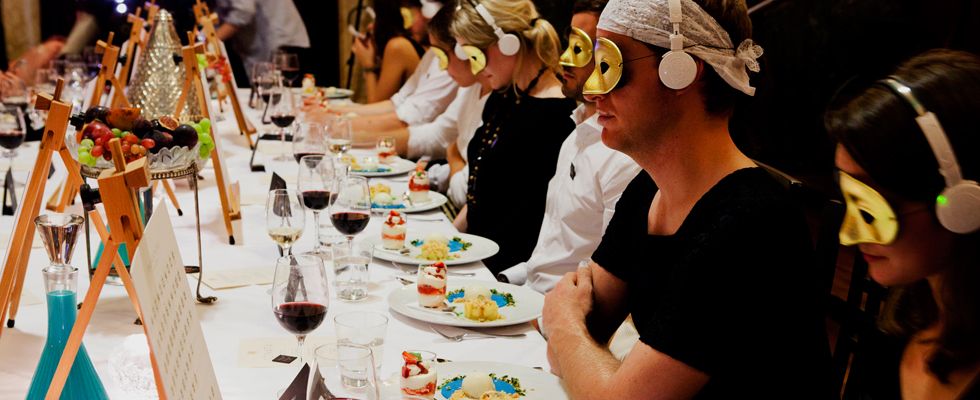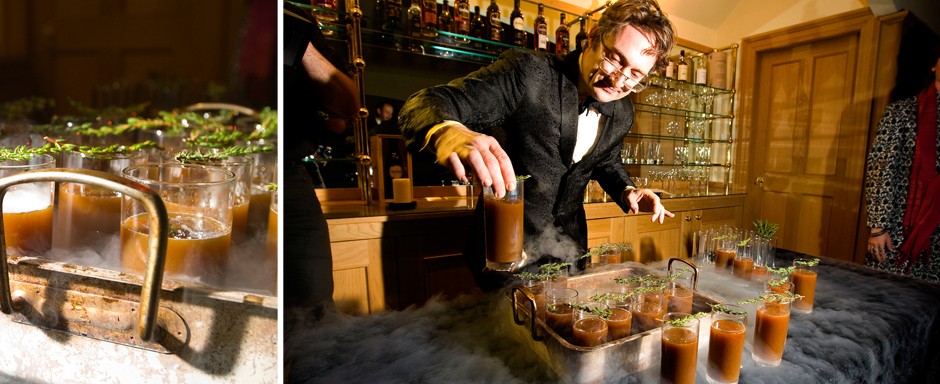Sensory Gastronomy
Culinary science gave us molecular gastronomy and the snail porridge. Now chefs are thinking beyond the plate and experimenting with our senses...

Molecular gastronomy – the use of scientific processes in cooking – has given us the snail porridge, the coffee flavoured lasagne and even the toenail-infused escalopes. Okay, it didn’t give us the last one – that’s made up. But in today’s Michelin-starred restaurant world, full of food combinations that deliberately make our bellies growl with curiosity, that peculiar dish wouldn’t look amiss.
Call it a post-Heston environment (in reference to the chef who pioneered culinary science with his Fat Duck restaurant). His celebrated restaurants might be a stretch for most people, but his television presence – along with his endorsement of the Waitrose supermarket – have helped to establish him, along with his scientific craft, as a household name.
So household, in fact, that individuals are now practising the art in their own home. Molecular kits aimed at the home cook enable anyone with an oven, kitchen top
and set of knives to indulge in the culinary science. Molecule-R, for instance, is a range of home kits that can be bought for as little as £40 – several pounds short of the average bill at The Fat Duck – and allow any budding chef to make experimental dishes such as chocolate spaghetti and mint caviar. Molecular food is now a little more democratic. Even the master himself, Heston, has declared the movement as ‘dead’, with a statement in a recent issue of The Observer’s Food Monthly saying the idea has become a novelty in modern cuisine. ‘The danger is that technology overtakes the value of the dish,’ he remarked.Diners want a unique custom-made experience that plays on all the senses, away from the homogeneity of chains and mass-dining – an experience that can’t be recreated.

But if consumers are trying scientific cooking at home, and if molecular food is jaded, what does this mean for the dining experience? For some chefs, the traditional white table cloth is going out the door, and being replaced with more challenging eating environments. KP Kofler, founder of nomadic dining event Kofler & Kompany, has worked with fine dining for years, but now sees things changing. ‘Normally,’ says Kofler, ‘if you go to a fine dining restaurant you see classic art on the walls and a formal atmosphere. But nowadays, people don’t want to be entertained in a way they are used to.’ As part of the last Frieze Art Fair, Kofler collaborated with street art curator Steve Lazarides to produce The Minotaur, a temporary dining and art event within the underground caverns of the Old Vic tunnels situated underneath London’s Victoria train station – possibly the last place you’d expect to see fine food.
Caroline Hobkinson, food writer and founder of experimental dining club Stirring With Knives, agrees that diners have become too familiar with traditional sit-down eating – particularly the tricks of molecular gastronomy. Instead, she thinks the role of science
in food is now about exploring and playing with the often ignored variables that exist beyond the plate. ‘Diners want a unique custom-made experience that plays on all the senses,’ she explains, ‘away from the homogeneity of chains and mass-dining – an experience that can’t be recreated.’ In other words, by playing with sounds, images, atmospheres, our emotions, and just about everything other then the food itself.
Hobkinson puts this into practice herself. She regularly hosts low-key dining events (deliberately kept small to create, as she calls it, ‘hyper-intimacy’) where guests can expect, well, the unexpected. They might be served food in syringes, or asked to eat dishes that dangle from the ceiling above them, or even spend the entire dinner masked, never quite knowing who they’re sat next to. ‘It amazes me how being masked loosens people up,’ she explains. ‘It allows them to be the most hedonistic version of themselves.’ Her next trick? A fragrance that she’s developing with a scent designer that when sprayed at the dinner table will help to enhance our eating experience. She’s also working with a musical composer to design what she calls a ‘culinary opera’.
Other chefs too are exploring similar sensory variables. At London Design Festival in September last year, an event called Secret Sensory Supers, curated by design agency FranklinTill, and held within an ancient masonry temple inside – would you believe it – Liverpool Street Station, explored how sound and vision can affect how we eat. At one of the evenings, called the MaSonic Suppers, instigated by sound design agency Silent Studios, guests were served food inspired by the structure of a musical sonata, and many were asked to play different musical instruments before they sat down to eat. At another evening during the event, this time hosted by the ubiquitous culinary artists and occasional jelly-mongers Bompass & Parr, guests watched surreal cult film classic Holy Mountain while the tucked into dishes such as pig’s ear soup. ‘Gird your loins,’ announced Sam Bompas prior to service, ‘the first two courses are rather savage.’ Caroline Till, one half of the event’s curators, explains the event was in response to growing questions around our consumerism, and how there is now an appetite for experiential moments. ‘There’s a thirst for creative and unusual non-material experiences,’ explains Till.
As well as building dining events based on experience, these events are also exploring an increasingly exciting area for science and dining: food psychology. We already know from psychological experiments, for instance, that when people drink white wine that’s coloured red, they think they’re drinking red wine, and will even go as far as to describe the taste in terms of red wine traits. And colour doesn’t just subvert our taste, it can also turn our stomachs. A study found that when people are served food that’s tinted blue with food dye, they are less likely to eat it. Even being served food inside a blue room will reduce our appetites. So why don’t we like to eat blue? It’s to do with our evolutionary instincts. Quite simply, there isn’t a lot of naturally occurring blue food, and our bodies are programmed to protect themselves against oddities like this in case it could be poisonous. And how about making our whole sense of taste redundant through what we see?
Scientists in Japan have created an augmented headgear device that lets the wearer experience a cookie’s taste as just about anything. The project, called Meta Cookie, uses a headgear device that displays a certain series of images of foods, which manage to trick the wearer into believing that they are about to eat those things. When they eat the cookie, it tastes of what’s being shown on the screens in the headgear.
More of these exciting discoveries could soon make their way into our dining experiences. And if experimental chefs increasingly explore these sensory food concepts, only time will tell whether they – in a similar way to how molecular gastronomy did – will eventually make their way into our kitchens at home.


